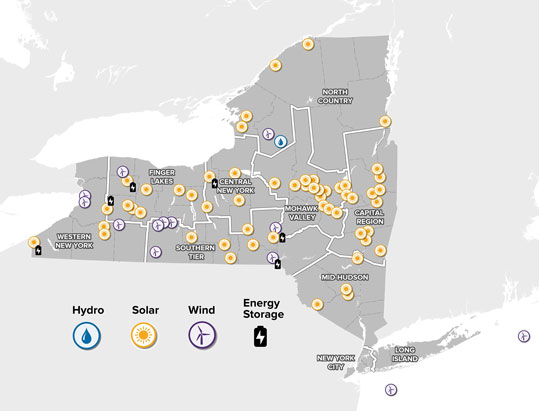Climate Change and Offshore Wind
Tackling the climate crisis
"Climate change is the existential challenge of our time, and New York State has risen to the occasion by enacting the strongest laws in the nation to protect and preserve our environment."
FORMER GOVERNOR ANDREW M. CUOMO
The Earth’s climate is changing at an alarming rate—this past decade was the hottest on record, with 2019 being the second warmest year ever. Warmer oceans, shrinking glaciers, and rising sea levels are further evidence that global warming has a grip on the planet, and now is the time for immediate action.
In order to diminish the occurrence of severe weather events caused by a changing climate, decisions about how to best respond to the climate crisis are needed, and New York is stepping up to take a major leadership role.
100% Clean Electricity by 2040 and 70% Renewable Sources by 2030
New York is making the transition to large-scale renewable energy, like offshore wind, which is crucial for lowering carbon emissions and advancing a clean energy future.
Large-Scale Renewable Energy: A Necessary Next Step
Renewable energy sources—such as onshore and offshore wind, hydroelectric, and solar—are important parts of a global strategy for tackling climate change. In countries across Europe, Asia, and the Americas, governments are enacting policies to combat global warming and spur market innovations.
New York State recognizes that significant increases in clean and renewable energy are necessary for real progress to be made. The State’s Climate Leadership and Community Protection Act ![]() (Climate Act) is the most aggressive climate legislation in the nation. Enacted in July 2019, the Climate Act requires utilities to rely on renewable energy for 70% of the electricity supply by 2030, with specific targets for 6,000 megawatts of solar capacity by 2025, 3,000 megawatts of energy storage capacity by 2030, and 9,000 megawatts of offshore wind by 2035.
(Climate Act) is the most aggressive climate legislation in the nation. Enacted in July 2019, the Climate Act requires utilities to rely on renewable energy for 70% of the electricity supply by 2030, with specific targets for 6,000 megawatts of solar capacity by 2025, 3,000 megawatts of energy storage capacity by 2030, and 9,000 megawatts of offshore wind by 2035.
Ramping Up Renewable Energy
Since 2017, NYSERDA has competitively selected and contracted with 69 projects comprising over 6,000 megawatts of renewable energy including large-scale solar, wind, and energy storage and offshore wind projects in the State.


Map shows renewable energy projects by region, as follows:
- Capital Region: (12)
- Central New York: Energy Storage: Solar (3)
- Finger Lakes: Energy Storage (2), Solar (8); Wind (1)
- Long Island: None
- Mid-Hudson: Solar (4)
- Mohawk Valley: Solar (12)
- New York City: None
- North Country: Hydro (1); Solar (5); Wind (1)
- Southern Tier: Energy Storage (2); Solar (6); Wind (5)
- Western New York: Energy Storage (1); Solar (3); Wind (3)
View more about renewable energy projects View more about renewable energy projects
Offshore Wind: An Emissions-Free Source of Energy
Deploying low-carbon energy sources like offshore wind is an essential solution for cutting greenhouse gas emissions to combat global warming.
Over the past few decades, the costs associated with offshore wind energy projects has declined dramatically, introducing an important resource opportunity for generating clean energy on a large scale. As a renewable energy source, offshore wind has a much smaller impact on the environment than conventional power generation based on fossil fuels. Large-scale offshore wind development addresses climate change by generating near limitless clean energy to power millions of homes without burning fossil fuels.
Additionally, reducing air pollution by even modest amounts in the densely populated regions of New York City and Long Island can have significant health benefits such as decreasing asthma-related and other respiratory and cardiovascular issues.
Offshore wind energy has the potential to transform New York State’s electricity system in ways that will have extraordinary environmental, social, and economic benefits. The State is working diligently to ensure that offshore wind is developed in the most responsible and cost-effective way possible.
Learn More
- Greenhouse Gas Emissions
 (U.S. Environmental Protection Agency)
(U.S. Environmental Protection Agency) - The Causes of Climate Change
 (NASA)
(NASA) - Climate Change Research
 (U.S. Environmental Protection Agency)
(U.S. Environmental Protection Agency) - Climate Action
 (United Nations Sustainable Development Goals)
(United Nations Sustainable Development Goals) - New York’s Climate Leadership and Community Protection Act
 (Climate Act)
(Climate Act)
